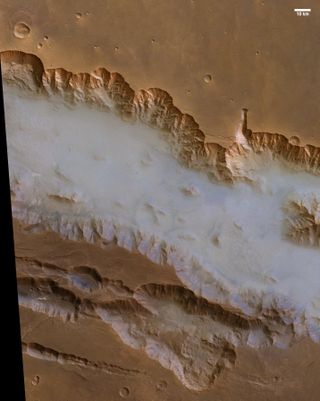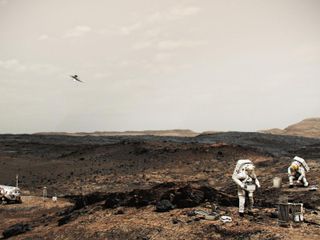How Astronauts Can Explore Mars' Grand Canyon, Valles Marineris
Many Mars exploration circles see Wallace Marineris as a “tell it all” place, ready for human exploration that can uncover the planet’s history and potential to sustain microbial life.
However, what is the best way to examine the multidimensional geological evidence at this site? Can the crew of the future Red Planet safely dive into this massive canyon system? And what awaits those who explore the vast area classified as the Grand Canyon of Mars?
JM Marineris is a huge advantage. The canyon system cuts through the Martian surface for 2,500 miles (4,000 km), covering about one-fifth of Mars’ circumference. At some points, this vast canyon is 125 miles (200 km) wide. In some places, the bottom of the canyon is 8 km deep.
Bottom line: Much deeper than Earth’s Grand Canyon.
related: Glaciers on Mars may have helped carve out the ‘Grand Canyon’ on the Red Planet
To encourage in situ human studies of Wallace Marineris, several experts have identified and named the area known as the “Noctic Landing” site. Its strategic location allows for the shortest surface visits of the volcanic plains of Mars Tharsis plus Valles Marineris – key features and regions on the Red Planet that reveal the longest record of Mars’ geology and evolution over time.
Tharsis is the region of Mars that has the longest and broadest volcanic history, and is probably still volcanically active. Some of the smallest lava flows on Mars have been identified on the west side of the Tharsis bulge.
In addition, it is included in the driving range for today’s future compact roving traversal.
top priority knowledge
Pascal Lee, a planetary scientist at NASA’s Ames, said, “It seems to me that, when planning a manned mission to Mars, we might want to think about theoretical scientific goals in a non-location-specific way.” is doing.” Research Center and SETI Institute in California.
Lee is president of the Mars Institute, an international, non-governmental and non-profit research organization dedicated to advancing the scientific study, exploration, and public understanding of Mars. He is also director of NASA’s Houghton-Mars Project, an international interdisciplinary field research project focused on the study of Martian analogues at the site of the Houghton impact crater on Devon Island in the High Arctic.
Lee told SPACE.com: We can now search for human landing sites and places where not all of our high-priority science goals can be met. These human landing areas offer several ways to extract water locally – some robotic reconnaissance missions can confirm – and where it makes sense to establish a base for long-term exploration, he said.
at the crossroads
Lee was pleased that the site called Noctis Landing was a flat transition zone between Noctis labyrinthus (Latin for “Night Labyrinth”) and Valles Marineris.
Not only does Noctis Landing offer a large number of sites and various areas of interest for short-term exploration, its strategic location at the crossroads between Tharsis and Valles Marineris, which is important for long-term exploration. This area is characterized by a deep, maze-like canyon system with steep walls.
“If you go east or south from Noctis Landing, you go all the way to Valles Marineris and you can look for signs of a past life,” he told me. “If you go west or north from Noctis, you climb a giant volcano on Mars with lots of caves, and you can look for life.”
no need for rock climbing
The result is that Noctis Landing is unique in that it lies at the literal intersection of the search for signs of past and present life on Mars.
For exploring Wallace Marineris, says Lee, the main advantage of Noctis Landing is that you can reach all the rock layers in the canyon without having to climb a cliff.
“Thanks to the large Odemans impact crater near Noctis Landing, a large slab of Walls Marineris canyon wall has been laid flat there, ready to be traced one by one from the rocky layers, just below the canyon,” Lee said. By driving along the floor.” ,
hidden water
Late last year, Igor Mitrofanov of the Space Research Institute of the Russian Academy of Sciences in Moscow, Russia, reported that large amounts of hidden water were visible at the center of Mars’ dramatic canyon system, Valles Marineris.
The observations came via the European Space Agency’s Roscosmos orbital gas tracker ExoMars (TGO). Mitrofanov is the principal investigator of the TGO Micro-Resolution Neutron Detection Telescope (FREND). The instrument maps hydrogen – a measure of water content – in the soil of upper Mars.
Mitrofanov and his colleagues found evidence of unusually high amounts of hydrogen in the core of Valles Marineris on Mars.
ambiguous combination of situations
“Using TGO, we can look down a meter below this layer of soil and see what’s really going on beneath the Martian surface – and most importantly, the water-rich ‘dew’ identifies what could not be detected with previous equipment,” Mitrofanov said. .. advertiser (opens in a new tab) In a statement issued by the European Space Agency.
“Assuming that the hydrogen we see is bound to a water molecule, 40% of the near-surface material in this region appears to be water,” Mitrofanov said.
As the ESA statement explains, the findings suggest that “a certain mix of precarious conditions must exist in Valles Marineris for the water to be conserved – or to be replenished in some way.”
Mitrofanov and his colleagues want to publish their work (opens in a new tab) In the March 2022 issue of the journal Icarus, it states: “Ice is not only an interesting material for the search for fragments of frozen proto-life or complex organic molecules from early Mars, but also important for future exploration.” There are also natural resources. Mars that is easy to exploit.”
fog bank
Lee from NASA confirmed the interesting finding of persistent smog in Valles Marineris. “Although the Martian atmosphere is generally believed to compress and absorb very little water vapour, the presence of ice fog, the most likely explanation for the cloud collections that frequently populate Valles Marineris, suggests that the Martian atmosphere may be locally saturated. Water, perhaps arriving in large quantities, can be extracted.”
Lee told me that the presence of fog on Wallace Marineris also indicates that at least one of the hydrogens discovered by Mitrofanov and his colleagues was most likely in the form of H2O, not just mineral water.
take a breath
Abigail Freeman, research scientist for the Mars Science Laboratory and deputy project scientist at NASA’s Jet Propulsion Laboratory, said the evacuation of Wallace Marineris’ science assets could be enhanced by aerial vehicles.
This view is clearly supported by the success of the Mars helicopter over NASA’s Jezero Crater.
“We can start imagining all sorts of possibilities for future exploration of Mars using the properties of the atmosphere,” Freeman told SPACE.com. “One of the advantages of exploring Mars by air is the ability to travel long distances through terrain that would be very dangerous for our discoverers.”
Freeman said Wallace Marineris is an example of a site that could really benefit from helicopter exploration. “This platform allows us to explore the ancient crust exposed in the canyon walls, the very steep sediment deposits in the center of the valley, and even the mysterious repeating slope line that runs steeply across Valles Marinis. occurs in rocks and can be formed by very salty liquid water.”
Exploring these features, Freiman said, “will help us answer questions about the entire history of Mars, from its first formation to the present day, and provide unprecedented insight into the mechanisms that drive Mars’ climate and habitability.” Affects its potential, as well as its rocky world. beyond our solar system.”
Follow us on Twitter tweet embed (opens in a new tab) or on Facebook (opens in a new tab),
#Astronauts #Explore #Mars #Grand #Canyon #Valles #Marineris


Comments
Post a Comment